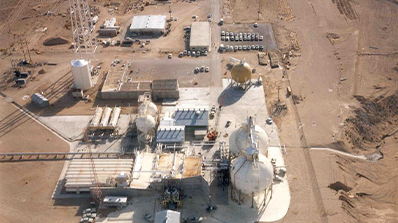The U.S. Department of Energy (DOE) Environmental Management (EM) Nevada Program and its environmental program services contractor, Navarro Research and Engineering, Inc., have initiated characterization and hazard reduction activities to prepare for upcoming demolition and closure work at two large, unique, and complex legacy nuclear facilities on the Nevada National Security Site (NNSS).
The facilities are the Engine Maintenance, Assembly, and Disassembly (EMAD) and Test Cell C (TCC) complexes, which have ties to historical nuclear propulsion rocket development and testing programs at the NNSS.
The characterization work being performed at EMAD and TCC is helping ensure future demolition and closure activities are conducted safely, securely, and successfully. Characterization is the process of identifying and analyzing contamination that could be hazardous to human health and the environment. Outlined in EM’s Strategic Vision for 2021-2031, the progress at EMAD and TCC represents the last major industrial-type facilities efforts identified in EM Nevada’s environmental remediation mission.
At EMAD, characterization and hazard reduction activities include the removal of light fixtures and electrical switches containing mercury, and excess chemicals containing hazardous components. Radiological control teams have finished sampling and characterization work to assess potential contamination for about 85 percent of the structures.

Working with NNSS management and operations contractor Mission Support and Test Services, the EM Nevada Program and Navarro recently used unmanned drones to perform aerial observations and inspections of the structure. Kordt Engineering Group, an independent consultant, also conducted a structural analysis to ensure the cooling tower on the roof is stable and the interior of the facility is safe for access and entry by personnel.
Constructed in 1968 at a cost of more than $50 million, EMAD is a four-story building with 100,000 square feet of floor space that includes what was once the largest hot cell in the world. A hot cell is a heavily shielded concrete room that provided workers protection from radioactive material when the facility was in operation.
Characterization and hazard reduction activities continue at TCC as well. Four buildings comprising approximately 13,790 square feet of space remain at the TCC complex. In addition, there is some infrastructure slated for demolition and closure that was part of a cooling system used during testing. An elevated potable water tank and flare stack piping used for venting during testing also will be removed.
EMAD and TCC were part of the now inactive Nuclear Rocket Development Station (NRDS). The NRDS supported the development and testing of nuclear rocket engines from 1957 until 1973. This jointly administered effort between the Atomic Energy Commission, predecessor to DOE, and the National Aeronautics and Space Administration was of such vital importance to U.S. interests at home and abroad that President John F. Kennedy toured the site in March of 1963.
The EM Nevada Program plans to initiate demolition at TCC and EMAD in 2022.

